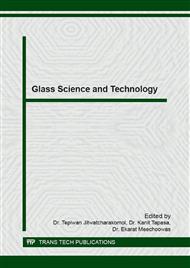[1]
E. Meechoowas, S. Poosrisoma, P. Jampeeruang and T. Jitwatcharakomol The effect of heat treatment on Fe2+/Fe3+ ratio in Soda-lime silicate glass, Key Engineering Materials, 659 (2015), 194-198.
DOI: 10.4028/www.scientific.net/kem.659.194
Google Scholar
[2]
F. V. Tooley, The handbook of glass manufacture 3rd, Ashlee Publishing Co., Inc. New York, (1984).
Google Scholar
[3]
C. Ruessel, Redox behaviour and electrochemical behavior of glass melts, in: L.D. Pye: Properties of glass forming melts. CRC Press, Boca Raton 2005, 27-56.
DOI: 10.1201/9781420027310.ch3
Google Scholar
[4]
H. Schirmer, M. Mueller and C. Ruessel, High-temperture spectroscopy study of redox reaction in iron and arsenic-doped melts. Glass. Sci. Technol. 76 (2003) 49-55.
Google Scholar
[5]
L. Kido, M. Mueller and C. Ruessel, Evidence of redox relaxation during thermal trement of soda lime silica glasses doped with chromium and manganese, Chem. Mater. 17(2005) 3929-3934.
DOI: 10.1021/cm040202k
Google Scholar
[6]
J. Kaufmann and C. Ruessel, Thermadynamic of Cu+/Cu2+ redox equlibrium in soda-silicate and soda-lime silicate melts., J. Non-Cryst. Solids. 355(2009) 531-535.
DOI: 10.1016/j.jnoncrysol.2009.02.004
Google Scholar
[7]
E. Meechoowas, M. Mueller and C. Ruessel, Redox relaxation in a sodium borosilicate glass doped with copper and arsenic, antimony, or tin, J. Non-Cryst. Solids. 356 (2010) 2528-2533.
DOI: 10.1016/j.jnoncrysol.2010.03.034
Google Scholar
[8]
M. Yamashita, T. Akai, R. Sawa, J. Abe and M. Matsumura, Effect of preparation procedure on redox states of iron in soda-lime silicate glass, J. Non-Cryst. Solids. 354 (2008) 4534-4538.
DOI: 10.1016/j.jnoncrysol.2008.07.002
Google Scholar
[9]
L. Kido, M. Mueller, I. Avramov and C. Ruessel, Redox freezing temperature and Bartenev equation in a 25Na2O-15B2O3-60SiO2 glass doped with chromium and manganese, J. Non-Cryst. Solids. 357 (2011) 3307-3312.
DOI: 10.1016/j.jnoncrysol.2011.05.027
Google Scholar
[10]
G. Gravanis and C. Ruessel, Redox reactions in Fe2O3, As2O3 and Mn2O3 doped soda-lime-silica glasses during cooling-a high-temperature EPR investigation, Glastech. Ber. 62(1989) 345-350.
Google Scholar
[11]
J. Hann, Annealing of glass containers and hollowware, Glass International. May (2013) 22-28.
Google Scholar
[12]
R. Klement, J. Kraxner and M. Liska, Spectroscopic analysis of iron doped glasses with composition close to the E-glass: A preliminary study, Ceram-Silik. 53 (2009) 180-183.
Google Scholar
[13]
M. Yamashita, T. Akai, R. Sawa, J. Abe and M. Matsumura, Effect of preparation procedure on redox states of iron in soda-lime silicate glass, J. Non-Cryst. Solids. 354 (2008) 4534-4538.
DOI: 10.1016/j.jnoncrysol.2008.07.002
Google Scholar
[14]
A. Ceglia, G. Nuyts, W. Meulebroeck, S. Cagno, A. Silvestri, A. Zoleo, K. Nys, K. Janssens, H. Thienpont and H. Terryn, Iron speciation in soda-lime-silica glass: a comparison of XANES and UV-vis-NIR spectroscopy. J. Anal. At. Spectrom. 30 (2015).
DOI: 10.1039/c5ja00046g
Google Scholar
[15]
C. Rüssel and E. Freude: Voltametric studies of the redox behaviour of various multivalent ions in soda-lime-silica glass melts. Phys. Chem. Glasses 30 (1989) 62-68.
Google Scholar
[16]
H. Schirmer, M. Müller and C. Rüssel: High-temperature spectroscopic study of redox reactions in iron- and arsenic-doped melts. Glass Sci. Technol. 76 (2003) 1-7.
Google Scholar


